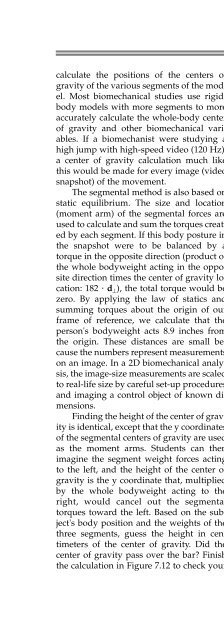Fundamentals of Biomechanics
Fundamentals of Biomechanics
Fundamentals of Biomechanics
Create successful ePaper yourself
Turn your PDF publications into a flip-book with our unique Google optimized e-Paper software.
calculate the positions <strong>of</strong> the centers <strong>of</strong><br />
gravity <strong>of</strong> the various segments <strong>of</strong> the model.<br />
Most biomechanical studies use rigidbody<br />
models with more segments to more<br />
accurately calculate the whole-body center<br />
<strong>of</strong> gravity and other biomechanical variables.<br />
If a biomechanist were studying a<br />
high jump with high-speed video (120 Hz),<br />
a center <strong>of</strong> gravity calculation much like<br />
this would be made for every image (video<br />
snapshot) <strong>of</strong> the movement.<br />
The segmental method is also based on<br />
static equilibrium. The size and location<br />
(moment arm) <strong>of</strong> the segmental forces are<br />
used to calculate and sum the torques created<br />
by each segment. If this body posture in<br />
the snapshot were to be balanced by a<br />
torque in the opposite direction (product <strong>of</strong><br />
the whole bodyweight acting in the opposite<br />
direction times the center <strong>of</strong> gravity location:<br />
182 • d ⊥), the total torque would be<br />
zero. By applying the law <strong>of</strong> statics and<br />
summing torques about the origin <strong>of</strong> our<br />
frame <strong>of</strong> reference, we calculate that the<br />
person's bodyweight acts 8.9 inches from<br />
the origin. These distances are small because<br />
the numbers represent measurements<br />
on an image. In a 2D biomechanical analysis,<br />
the image-size measurements are scaled<br />
to real-life size by careful set-up procedures<br />
and imaging a control object <strong>of</strong> known dimensions.<br />
Finding the height <strong>of</strong> the center <strong>of</strong> gravity<br />
is identical, except that the y coordinates<br />
<strong>of</strong> the segmental centers <strong>of</strong> gravity are used<br />
as the moment arms. Students can then<br />
imagine the segment weight forces acting<br />
to the left, and the height <strong>of</strong> the center <strong>of</strong><br />
gravity is the y coordinate that, multiplied<br />
by the whole bodyweight acting to the<br />
right, would cancel out the segmental<br />
torques toward the left. Based on the subject's<br />
body position and the weights <strong>of</strong> the<br />
three segments, guess the height in centimeters<br />
<strong>of</strong> the center <strong>of</strong> gravity. Did the<br />
center <strong>of</strong> gravity pass over the bar? Finish<br />
the calculation in Figure 7.12 to check your<br />
CHAPTER 7:ANGULAR KINETICS 183<br />
guess. The segmental method can be applied<br />
using any number <strong>of</strong> segments, and in<br />
all three dimensions during 3D kinematic<br />
analysis. There are errors associated with<br />
the segmental method, and more complex<br />
calculations are done in situations where<br />
errors (e.g., trunk flexion/extension, abdominal<br />
obesity) are likely (Kingma,<br />
Toussaint, Commissaris, Hoozemans, &<br />
Ober, 1995).<br />
Activity: Center <strong>of</strong> Gravity<br />
and Moment <strong>of</strong> Inertia<br />
Take a 12-inch ruler and balance it on<br />
your finger to locate the center <strong>of</strong> gravity.<br />
Lightly pinch the ruler between your<br />
index finger and thumb at the 1-inch<br />
point, and allow the ruler to hang vertically<br />
below your hand. Swing the ruler in a<br />
vertical plane and sense the resistance <strong>of</strong><br />
the ruler to rotation. Tape a quarter to<br />
various positions on the ruler and note<br />
how the center <strong>of</strong> gravity shifts and how<br />
the resistance to rotation changes.Which<br />
changes more: center <strong>of</strong> gravity or moment<br />
<strong>of</strong> inertia? Why? What factors make<br />
it difficult to sense changes in ruler moment<br />
<strong>of</strong> inertia?<br />
PRINCIPLE OF BALANCE<br />
We have seen than angular kinetics provides<br />
mathematical tools for understanding<br />
rotation, center <strong>of</strong> gravity, and rotational<br />
equilibrium. The movement concept <strong>of</strong> balance<br />
is closely related to these angular kinetic<br />
variables. Balance is a person's ability<br />
to control their body position relative to<br />
some base <strong>of</strong> support (Figure 7.13). This<br />
ability is needed in both static equilibrium<br />
conditions (e.g., handstand on a balance<br />
beam) and during dynamic movement<br />
(e.g., shifting the center <strong>of</strong> gravity from the






